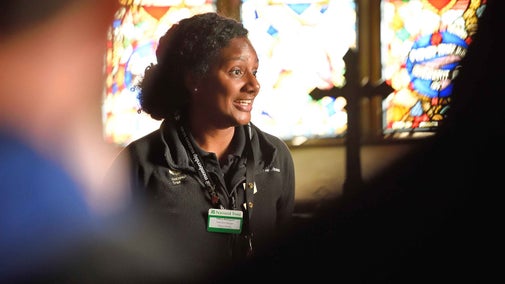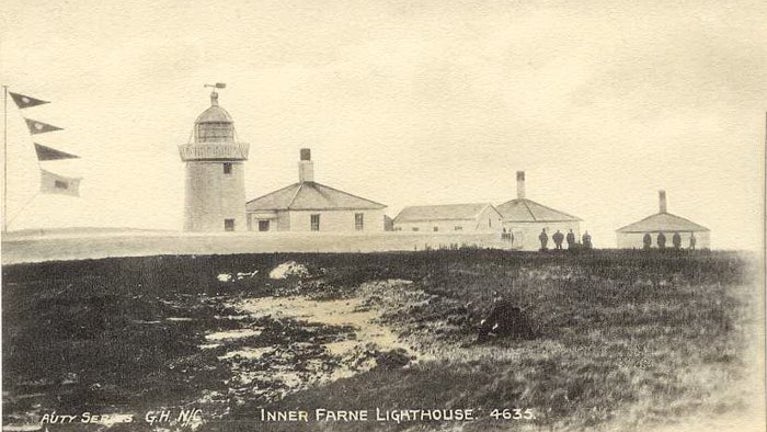A century of care

As we mark the centenary of the Farne Islands being under the care of the National Trust, we celebrate a journey of conservation, heritage, and natural beauty.
For 100 years, these rugged islands off the coast of Northumberland have been a sanctuary for wildlife and a haven for nature enthusiasts. From the bustling seabird colonies to the Atlantic grey seals, the Farne Islands are a testament to conservation.
A rich cultural heritage
Early Inhabitants
The islands have a rich history dating back to the 7th century when they were inhabited by monks and hermits. Saint Aidan and Saint Cuthbert are among the most notable early residents. Saint Cuthbert, in particular, is known for introducing some of the earliest bird protection laws in 676 AD.
Monastic Life
In the 12th century, the islands became home to a small Benedictine monastic cell, which was dependent on Durham Abbey. This cell was dissolved in 1536 during King Henry VIII's Dissolution of the Monasteries
Grace Darling
The Farne Islands are also famous for Grace Darling, the daughter of the Longstone lighthouse keeper. In 1838, she became a Victorian heroine after she and her father rescued nine survivors from the wrecked ship the Forfarshire.
Lighthouses
The islands have several historic lighthouses, including the Longstone Lighthouse, which was the home of Grace Darling. These lighthouses have been crucial in ensuring the safety of ships navigating the treacherous waters around the islands
The Wildlife
The Farne Islands are a haven for a diverse array of wildlife, making them a must-visit for nature enthusiasts. Here are some of the key species you can find:
Seabirds: The islands are home to 200,000 seabirds during the breeding season, including eider ducks, cormorants, shags, fulmars, kittiwakes, Arctic terns, common terns, Sandwich terns, guillemots, and razorbills. And of course, the charismatic puffins.
Atlantic Grey Seals: The islands host one of the UK's largest grey seal colonies, with over 3,000 pups born each autumn. Seals can be spotted year-round.
Depending on the time of year you visit, you might also spot other wildlife such as cetaceans and different migratory birds.
Past
Conservation practices have changed over the last 100 years, but the birds and the buildings have remained constant.
Conservation on the Farne Islands
The care of the islands has been vital for ensuring the returning birds have the best conditions in which to breed. The Trust took over ownership of the Islands from the Farne Islands Association (FIA) on 10 August 1925, which continued to manage the islands until the Trust formally took over this role in 2000. The Trust took over the monitoring of seabirds in the middle of the last century, and due to the growing numbers and variety of species recorded, they were declared a National Nature Reserve in 1993. It’s these records that have helped inform conservation work on the islands. Conservation efforts on the Farne Islands have evolved significantly over the past century, as we work to future proof the significant natural and cultural heritage of this very special place.
The earliest official scientific records for seabirds date from 1913. Reports for the majority of returning bird species started in the 1920s thanks to the ‘watchers’ stationed on the islands over the summer period, and in 1939 puffins were particularly noted as increasing.
It appears that the increases in bird species aligns with the islands gaining increased environmental protections, firstly through designation as a Site of Special Scientific Interest (SSSI) in 1951 and as a Special Protected Area (SPA) in 1985.
Significant milestones include numbers of breeding birds reaching 100,000 for the first time in 1987, with 200,000 individual seabirds returning recorded in 2005.
Looking back on the records for the different populations it is very clear how important regular monitoring of the different seabird populations has been – despite different methodologies - for informing our conservation work on the islands, but also for keeping track of the impacts of climate change through warming seas and more frequent storms.
Some areas of Inner Farne are also protected as a Scheduled Monument, which designates the site as a nationally important archaeological site.
Early Protection
The earliest recorded conservation efforts date back to St Cuthbert in the 7th century, who supposedly introduced laws to protect the eider ducks especially, but also other seabirds. This would be one of the first instances of wildlife protection in history, and to this day the Eider Ducks are known locally as “Cuddy Ducks”.
Over the course of the last century, the National Trust has focused on preserving the natural habitat and protecting the wildlife. In addition, work has been regularly carried out to ensure the survival of the built heritage on the islands, including major repairs to Prior Castell’s Tower in the 1920s, 1950s, and 1970s.
Scientific Research
Over the years, scientific research has played a crucial role in conservation and our understanding of the populations of birds that return here each year to breed, including puffins which are on the Red List. Studies on bird populations, seal colonies, and the impact of human activities have informed conservation practices over the last century.
We submit our data to the British Trust for Ornithology (BTO) and the Seabird Monitoring Programme (SMP) so our data can be used by researchers and for other studies.
Other sites submit their data into these sources too, to give a complete picture of what is happening to the various populations.
Modern Conservation Techniques
Advances in technology have enhanced conservation efforts. For example, satellite tracking of birds (Arctic terns on the Farnes) provides valuable data on their movements and behaviour, helping us to any tailor conservation strategies on the ground .In using tracking technology we were able to discover for the first time just how far the Arctic terns travel during their annual migration with distances of up to 70,800 miles recorded – or to put this into context, close to three times around the globe each year which means they witness two summers!
To help monitor the puffins and to gain further insights into these ‘clowns of the sea’, the team is introducing a new way to track the birds using coloured rings – the second such project in England.
Despite puffins spending much of their time ‘rafting’ out at sea, ringing them will help us to understand more about the individuals as we’ll be able to follow them over several years, as well as how long they live and how far they travel to other colonies
The Farne Islands hold the longest running data set for grey seal monitoring in the world, and in recent years the rangers have used cutting edge thermal drone technology to count the seal pups born on the colony, enabling a higher level of accuracy in our counting and less disturbance to the seals.
Adapting to climate change
In recent years, conservation efforts have increasingly focused on adapting to challenges facing the birds that live here, including climate change, food shortages and Avian Influenza. This has included monitoring changes in bird populations, and last year we were able to carry out the first full puffin census in five years, as Covid and then Avian Influenza had meant that we were able to get only a partial picture around how the population was faring.
Our buildings feature several listed structures, including the Grade 1 Prior Castell’s Tower and the Grade 2 St Cuthbert’s Chapel. Many buildings on Inner Farne sit within a Scheduled Monument, which recognises their archaeological significance, but more importantly the Pre-Conquest Monastic cell and settlement relating to the occupation of the site by St Aidan and St Cuthbert.
Due to being in such an exposed location, these buildings are also vulnerable to climate change and the conservation and care of the important cultural heritage on the Farne Islands will be a key focus of the Future Farnes project. Archaeological assets are at risk from both rising sea levels and the impact of increased or changing wildlife use, such as puffin burrowing and seal haul-outs.
Inner Farne Lighthouse
Some things haven't changed all that much...
The future
It’s hard to know what the famous bird colonies will be like in 50 or 100 years. Because of rising sea levels and warming seas, we could be seeing an entirely different position on the Farne Islands. But one thing is certain, the National Trust will be working to conserve them.
A Century of Care: Discover why the Farne Islands remain a special place for people and wildlife.
A wild and remote cluster of islands just 5 miles off the coast of Northumberland, a short boat trip can transport you to a place like no other. The Farne Islands have long been a sanctuary for wildlife and a place of deep cultural significance. The National Trust began caring for the Farne Islands in 1925 and 100 years later, it remains a special place for wildlife and visitors alike.
Allow video to play? This page contains content that is published to YouTube.
We ask for your permission before anything is loaded, as this content may introduce additional cookies. You may want to read the Google YouTube terms of service and privacy policy before accepting.
Planning your visit to the Farne Islands
Inner Farne is now closed for landings until 1 April 2026. To sail around the Farne Islands, or land on Inner Farne you need to catch a boat from Seahouses harbour. It's recommended that you book your boat trip in advance. Read on to find out how to book and what to expect from your trip, and things to think about as you plan your visit.

History of the Farne Islands’ inhabitants
Many people have called the Farne Islands home over the centuries, from hermits and monks to soldiers, lighthouse keepers and even shipwrecked sailors.






